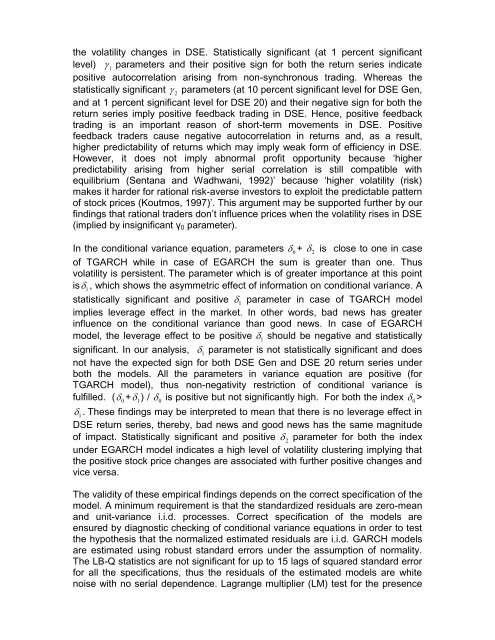Feedback trading behavior in Dhaka Stock Exchange (DSE ...
Feedback trading behavior in Dhaka Stock Exchange (DSE ...
Feedback trading behavior in Dhaka Stock Exchange (DSE ...
You also want an ePaper? Increase the reach of your titles
YUMPU automatically turns print PDFs into web optimized ePapers that Google loves.
the volatility changes <strong>in</strong> <strong>DSE</strong>. Statistically significant (at 1 percent significant<br />
level) <br />
1<br />
parameters and their positive sign for both the return series <strong>in</strong>dicate<br />
positive autocorrelation aris<strong>in</strong>g from non-synchronous <strong>trad<strong>in</strong>g</strong>. Whereas the<br />
statistically significant <br />
2<br />
parameters (at 10 percent significant level for <strong>DSE</strong> Gen,<br />
and at 1 percent significant level for <strong>DSE</strong> 20) and their negative sign for both the<br />
return series imply positive feedback <strong>trad<strong>in</strong>g</strong> <strong>in</strong> <strong>DSE</strong>. Hence, positive feedback<br />
<strong>trad<strong>in</strong>g</strong> is an important reason of short-term movements <strong>in</strong> <strong>DSE</strong>. Positive<br />
feedback traders cause negative autocorrelation <strong>in</strong> returns and, as a result,<br />
higher predictability of returns which may imply weak form of efficiency <strong>in</strong> <strong>DSE</strong>.<br />
However, it does not imply abnormal profit opportunity because ‘higher<br />
predictability aris<strong>in</strong>g from higher serial correlation is still compatible with<br />
equilibrium (Sentana and Wadhwani, 1992)’ because ‘higher volatility (risk)<br />
makes it harder for rational risk-averse <strong>in</strong>vestors to exploit the predictable pattern<br />
of stock prices (Koutmos, 1997)’. This argument may be supported further by our<br />
f<strong>in</strong>d<strong>in</strong>gs that rational traders don’t <strong>in</strong>fluence prices when the volatility rises <strong>in</strong> <strong>DSE</strong><br />
(implied by <strong>in</strong>significant γ 0 parameter).<br />
In the conditional variance equation, parameters <br />
0<br />
+ <br />
2<br />
is close to one <strong>in</strong> case<br />
of TGARCH while <strong>in</strong> case of EGARCH the sum is greater than one. Thus<br />
volatility is persistent. The parameter which is of greater importance at this po<strong>in</strong>t<br />
is 1<br />
, which shows the asymmetric effect of <strong>in</strong>formation on conditional variance. A<br />
statistically significant and positive <br />
1<br />
parameter <strong>in</strong> case of TGARCH model<br />
implies leverage effect <strong>in</strong> the market. In other words, bad news has greater<br />
<strong>in</strong>fluence on the conditional variance than good news. In case of EGARCH<br />
model, the leverage effect to be positive <br />
1<br />
should be negative and statistically<br />
significant. In our analysis, <br />
1<br />
parameter is not statistically significant and does<br />
not have the expected sign for both <strong>DSE</strong> Gen and <strong>DSE</strong> 20 return series under<br />
both the models. All the parameters <strong>in</strong> variance equation are positive (for<br />
TGARCH model), thus non-negativity restriction of conditional variance is<br />
fulfilled. ( 0<br />
+ 1<br />
) / <br />
0<br />
is positive but not significantly high. For both the <strong>in</strong>dex <br />
0<br />
><br />
<br />
1. These f<strong>in</strong>d<strong>in</strong>gs may be <strong>in</strong>terpreted to mean that there is no leverage effect <strong>in</strong><br />
<strong>DSE</strong> return series, thereby, bad news and good news has the same magnitude<br />
of impact. Statistically significant and positive <br />
2<br />
parameter for both the <strong>in</strong>dex<br />
under EGARCH model <strong>in</strong>dicates a high level of volatility cluster<strong>in</strong>g imply<strong>in</strong>g that<br />
the positive stock price changes are associated with further positive changes and<br />
vice versa.<br />
The validity of these empirical f<strong>in</strong>d<strong>in</strong>gs depends on the correct specification of the<br />
model. A m<strong>in</strong>imum requirement is that the standardized residuals are zero-mean<br />
and unit-variance i.i.d. processes. Correct specification of the models are<br />
ensured by diagnostic check<strong>in</strong>g of conditional variance equations <strong>in</strong> order to test<br />
the hypothesis that the normalized estimated residuals are i.i.d. GARCH models<br />
are estimated us<strong>in</strong>g robust standard errors under the assumption of normality.<br />
The LB-Q statistics are not significant for up to 15 lags of squared standard error<br />
for all the specifications, thus the residuals of the estimated models are white<br />
noise with no serial dependence. Lagrange multiplier (LM) test for the presence

















